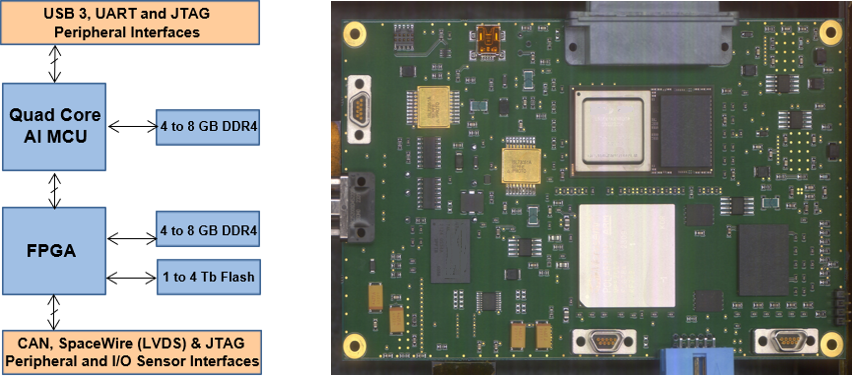OBP Products
Spacechips Edge 1

Are you looking for a small, low-power, AI-enabled, on-board processor that will enable you to exploit in-orbit machine learning? Are you an Earth-Observation operator wanting to perform more on-board processing in real-time, in-orbit, rather than downlink bandwidths of data for slow, cloud-based post processing on the ground?
Would you like to exploit machine learning to extract the valuable insights your customers desire from live sensor data in real-time? Are you a Space Debris, De-Commissioning or Defence operator wanting to perform space-domain awareness to detect and classify the trajectory and intent of other orbiting objects in real-time?
Architecture : Four 32-bit/64-bit Arm® Cortex®-v8 A72 CPUs with AI accelerators as well as an ultra-deep-submicron flash FPGA: the operation of both processors can be re-programmed in-orbit using their peripheral interfaces.
Performance : Scalable from one core at 4,720 DMIPS (8 GFLOPs) to four cores offering 34,000 DMIPS (57.6 GFLOPs), as well as a 500 MHz, ultra-deep-submicron flash FPGA ranging from 200 to 500k logic elements.
Power Consumption : Scalable from 4 to 25 W based on number of CPU cores, processors and clock frequency.
Power Interfaces : +5 or +28 V with reverse-polarity protection and soft start.
Storage : 8 to 12 GB of fast DDR4 SDRAM and 1 to 4 Tb of fast, non-volatile NAND flash.
Peripheral Interfaces : LVDS (SpaceWire), CAN, UART and USB 3.
Sensor Interfaces : 32 12.5 Gbps high-speed serial links (SpaceFibre) and 32 GPIO, both configurable to desired electrical formats, e.g. CML, LVPECL, LVDS, sub-LVDS, LVCMOS and LVTTL.
Dimensions : PCB = 95.8 x 149 mm, case can be customer specific
Reliability : suitable for LEO, MEO and GEO missions, TRL 4, 40°C to +100°C TJ
Spacechips SDR 1

Are you a telecommunications operator wanting to re-use a single receiver for multiple RF frequency bands and change in real-time, its ability to receive different carrier frequencies, information bandwidths, modulation and waveform types in response to varying communication and traffic needs?
Do you require a small, low-power, smart SIGINT or ELINT SDR to monitor the RF frequency spectrum from UHF to Ku-band?
Architecture : One or two 12-bit, RF ADCs each sampling up to 500 or 800 MHz of bandwidth with AGC to maximise SNR. Six selectable frequency bands can be processed by each ADC: 1 to 2 GHz, 2 to 4 GHz, 4 to 8 GHz, 8 to 12 GHz, 12 to 15 GHz and from 1 to 15 GHz. Instantaneous processed bandwidth as well as on-board processing can be changed in-orbit.
Power Interfaces : +5 or +28 V with reverse-polarity protection and soft start
Storage : 4 to 8 GB of fast DDR4 SDRAM and 1 to 4 Tb of fast, non-volatile NAND flash
Peripheral Interfaces : LVDS (SpaceWire), CAN, UART and USB 3
Power Consumption : Scalable up to 15 W
RX Sensitivity : depends on carrier statistics with RF input power of -100 dBm detected and processed
RX Dynamic Range : 72 dB
RX Noise Figure : ranges from 3 to 4.3 dB depending on frequency band
Mechanical : 150 x 150 x 50 mm, cased, lifetime of 3 to 5 years, operating temperature from -40 to +85 °C
Please email, info@spacechips.co.uk, to discuss how Spacechips' enabling products can enable your mission aspirations!

New Company of 2017 and High-Reliability Product of 2017

High-Reliability Product of 2016

International Company of 2018

Top 100 StartUp